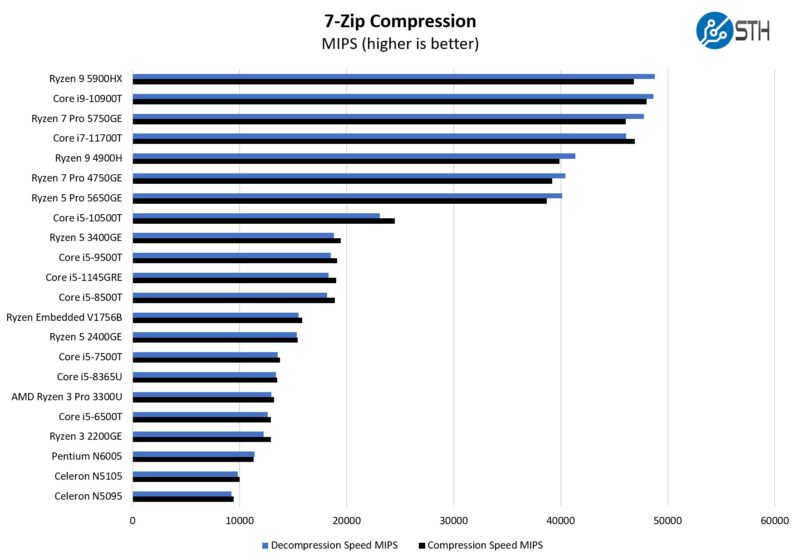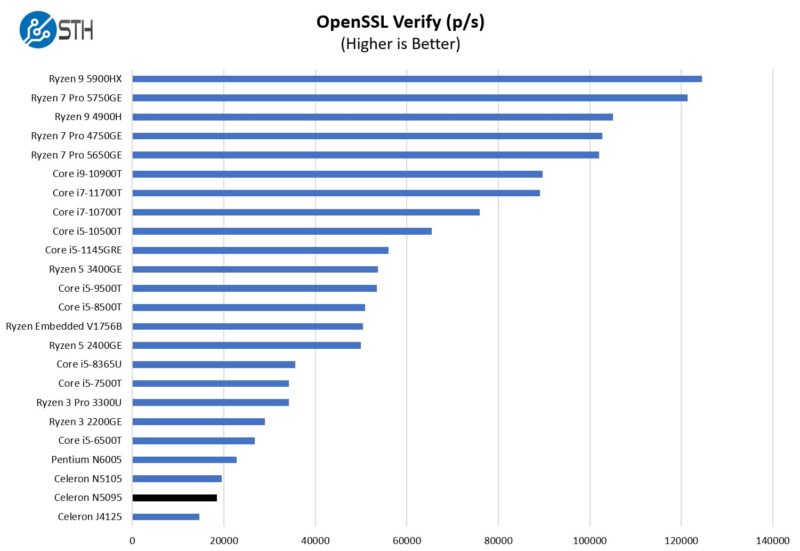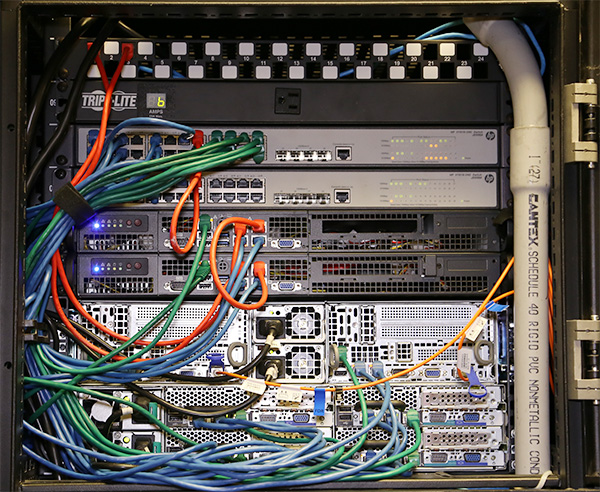Intel Celeron N5095 Performance
We wanted to just quickly look at the relative CPU performance between this unit and a few others on the market. We have reviewed this form factor with the J4125, N5105, and N6005 as well, so we are really looking for the relative performance between those four options.
Python Linux 4.4.2 Kernel Compile Benchmark
This is one of the most requested benchmarks for STH over the past few years. The task was simple, we have a standard configuration file, the Linux 4.4.2 kernel from kernel.org, and make the standard auto-generated configuration utilizing every thread in the system. We are expressing results in terms of compiles per hour to make the results easier to read:

Here we just wanted to show that the performance was near the AMD Pro A10-8707E we found in our Project TinyMiniMicro HP EliteDesk 705 G3 Mini CE Review. This is a much newer and lower power CPU, but that HP review set off our Project TinyMiniMicro series.
7-zip Compression Performance
7-zip is a widely used compression/ decompression program that works cross-platform. We started using the program during our early days with Windows testing. It is now part of Linux-Bench.

Here we just wanted to show that modern “big core” CPUs fairly easily out-pace this solution. Even going back to the 4C/ 4T Intel Core i5-6500T versus the N5095 4C/ 4T platform, we see the six (soon seven) generation old Core processor was faster than this. When we run Proxmox VE on these nodes, then put pfSense or OPNsense on them, we are really looking at virtualizing lightweight services not doing heavier virtualization. If you want a better virtualization host, the Project TinyMiniMicro platforms are better.
OpenSSL Performance
OpenSSL is widely used to secure communications between servers. This is an important protocol in many server stacks. We first look at our sign tests:

Here are the verify results:

Still, compared to the J4125, these are faster by quite a bit. For a basic firewall/ NAT box, the J4125 is still a good option as it uses less power.
4x 2.5GbE pfSense NAT Testing
Since we got asked, here is a pfSense VM on Proxmox VE using our How to Pass-through PCIe NICs with Proxmox VE on Intel and AMD guide (more on that later in this review) passing traffic over two dedicated NICs using NAT and 10 firewall rules and zero additional tunings.
We again saw line rate 2.5GbE speeds (~2.3-2.4Gbps.) During stress testing, we also raised the ambient temperature to 28-29C and had no issues running multi-day tests. The benefit of the faster processor is being able to add more to IDS and other features on the box with a bit more headroom. Still, for basic cases, even installing pfSense/ OPNsense in a Proxmox VE VM and pushing traffic both from the base OS, but also from the VM’s across all four NICs worked fine.
Next, let us get to power consumption, noise, and our final words.
Power Consumption and Noise
Power consumption on these was interesting. We have received a number of reports that the Jasper Lake power supplies that come with the Topton and KingNovy units are of very poor quality. We have had readers replace the PSUs and save a few watts. At the same time, our other sense is that most of our readers will use the standard power supplies. Admittedly, with the J4125 units that use significantly less power, we have a few now on PoE+ splitters.
At idle, we saw between 11-12W depending on single versus double SODIMM configurations. Maximum power consumption hit just over 27W. This is a few watts more than we saw on our N5105 unit and quite a bit more than we saw on the J4125 units.
These boxes are designed to largely be “always-on” devices. Saving a few watts may be a big or small deal. In some places in Europe, power is $3-7 per watt per year, so saving a few watts adds up quickly, especially on always-on devices.
Next, let us get to our key lessons learned.




Living in Europe, I do appreciate your concern for the power consumption of the device!
However, I’m not sure your advice is sound.
Short variant: in an appliance context the max power consumption isn’t nearly as significant as the average power consumption for the job its doing–and that may be neglegable for those different bins.
Long variant:
All these Jasper Lake variants (perhaps even the dual cores) are most likely made from the same set of dice and just binned for outright defects, higher voltage requirements or even pure market segmentation.
In the case of voltage bins, that’s typically chips requiring higher voltages to overcome less than perfect transistores or interconnects, but it could also be chips that simply won’t run reliably at higher clocks.
In the first case an N5095 is liklely to consume more Watts than a N6005 at identical CPU core clocks. In the second case there might be no difference, though typically the two cases aren’t really isolated from one another.
These being 24×7 appliances, idle power consumption is really the bigger factor and the principal reason you should pay close attention to the power supply and it’s efficiency. Yet for the Jasper Lake SoCs, I’d expect very little difference. The difference in power consumption only really comes into play as these chips rev to near maximum clocks. And there somewhat like its Rocket Lake cousins, Jasper Lakes is happy to go into power consumption territory where no Atom has gone before: My J5005 based systems tend to stick pretty close to the 10Watt TDP mark they officially have, while my Jasper Lake N6005 NUC has been observed to really burn the 28Watt PL2 TDP the BIOS allocates by default.
Well, unlike my fully passive J5005 Mini-ITX systems (which never throttle!), it also has a fan…
But at least on the NUC BIOS you can tell it to keep it down and make do with 12 Watts PL2 and 10 Watts PL1, at which point it sure won’t be using more than a N5095, but it might not be much faster either (well Atoms are no speed daemons anyway).
Essentially with the N6005 you get a bit more choice and flexibility: you can let it rip near the maximum speed at the cost of the extra power or you can tone it down, if efficiency really were your top concern. You can’t change your mind with the 5095 and open up that throttle once you notice that that nice new broadband bandwidth update fails to make it through your firewall.
But even without restricting the BIOS TDP setting, chances are the practical difference in terms of power consumption between the top bin Jasper Lake and its lower variants won’t be noticeable, because if you operate them near those top clocks for extended periods of time, you’re most likely using the wrong platform: at 28 Watts a Core mobile part will give you more performance per Watt because that’s operating near its peak efficiency point there, than an Atom that’s left that point far behind and has little left to give except heat.
A couple of years ago I had to migrate from an J1900 Atom to a Kaby Lake i7-7700T Core CPU (35 Watt TDP) for my pfSense firewall , because with all the Suricata rulesets active, an Atom was quite overwhelmed and throttling the broadband bandwith, so be sure to measure realistically before you buy.
My only real comment is that the ranking on the first page is unclear, you put the N5095 at the top when in reality it was worst to best. So I started the article wondering why the ranking was backwards. Perhaps some refinement to qualify the order of the ranking could improve it a bit!
Hello everybody,
I want to give you my input on this, I bought this one, to use it as a router (VM in Proxmox, PCI passthrough), besides a router, I will host a Pihole, Home assistant, and an Unifi Controller, so 4 VM in total.
Also, I got a micro PC(Noname as this one) with just two NICs to do the same.
For the 4 ports I got branded memory and SSD, and for the 2 ports, I got it populated with Noname memory and SSD.
BOTH of them are not stable, the VM is crashing every few days, proxmox still works but the machines are crashing randomly, I disabled qemu guest agent and the crashes are happening half as much but still there, I have a lot of experience with proxmox with hundreds of VM hosted on it but I never saw this.
I will ditch them and return to Dell/Lenovo mini and micro PCs, even if they are a few generations behind. before those, I had a Dell 3020 that ran for more than two years without problems.
If you have thoughts please share them :)
Thanks for reading, I hope it helps.
I feel like I’m getting lost here.
I want to ditch my UniFi USG-3 in favor of going more opensource with PfSense.
I watched multiple of these fanless router videos so far and I still have no clue on what I should get.
4 ports should be fine, or maybe even 2 port, for WAN and LAN as I can do VLANing on my switches. Or is there a benefit in having a dedicated LAN port for each VLAN?
But I’m mainly getting lost at the CPU selection.
Should I go for N6005, N5105, i7-1165G7, or one of the i3/i5 options?
The system would probably run PfSense directly, maybe via Proxmox so I can save a back-up on my NAS. Some IDS/IPS would be nice, as well as VPN. PiHole already runs on my fanless Docker box (N5095).
I installed a protectelli (not sure of spelling) pfSense for my brother. Mostly game traffic (3 consoles, 720p streaming to multiple devices, then phones, and pc’s etc). Pretty sure we did the 4 port intel atom or something like that (not high end is the point). It does a great job and there are no regrets other than should have bought one for me too. It’s nice to have 4 ports.
Good article, it certainly doesn’t make any sense to upgrade these kind of PC’s with a Celeron.
I personally bought a Geekom Mini Air 11 with the N5095 and the only thing I did was upgrade RAM to 16Gb by adding a 8Gb stick to get dual channel. I really don’t think it actually had much affect. I also think Windows 11 runs fine up to a point, but I think a more efficient Linux distro probably works better for these tiny PC’s. I do think you get some advantage with 4 cores now rather then the Celeron’s with only two.